
Ohio Wildlife Center is here to help. If you have found a wild animal and need to know how to help it, please follow the questions below. You’ll have a solution in less than three minutes as you walk through these simple questions and answers.
To reach a wildlife expert in Central Ohio:
Outside of Central Ohio? Locate an expert in your area.
No matter your situation, always use caution when approaching a wild animal. Keep children and pets away from these situations, too.


If the animal has bleeding, broken bones or another obvious injury – you can bring the animal to Ohio Wildlife Center’s Hospital during open hours. See Options for safely containing and transporting different types of animals.
.

Sounds like you need professional help. SCRAM! Wildlife Control is our fee-based service offering humane eviction and exclusion services. Our qualified technicians are here to help!
If you are outside of Central Ohio, please call your nearest humane society and ask if there is a humane, non-lethal company in your area that can help with your uninvited guests.
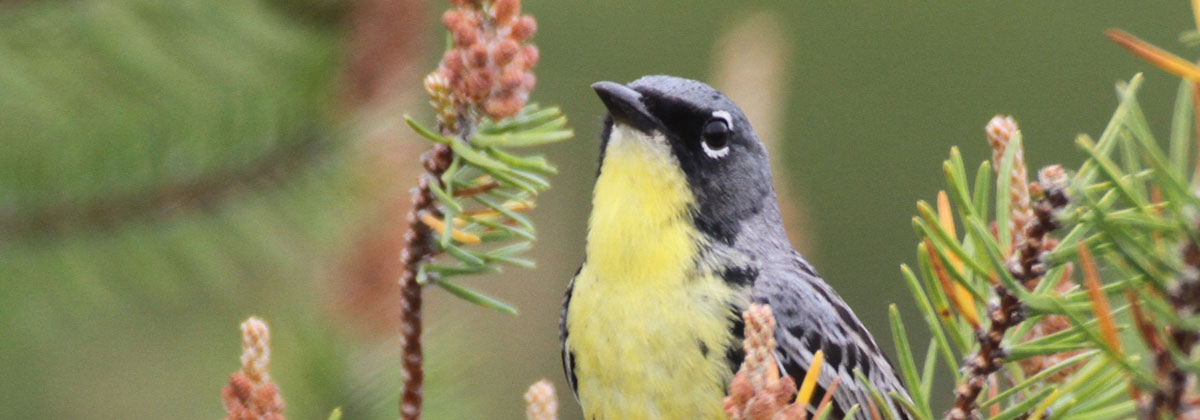
Many people find birds that look like they need help. Some fall out of the nest too soon and do need help, but many are meant to be on the ground as young birds called fledglings and they should be left alone.
It is common for baby birds to fall out of the nest. Fortunately, their bones are still developing at this time, so the bird has less of a chance of serious injury from the fall. Birds usually fall straight down unless there have been severe winds.
After placing the bird in the determined spot, watch from a respectable distance for 30-60 minutes to ensure the parents are returning to feed the bird. If the adults haven’t returned by this time, the bird(s) is likely orphaned and should be admitted to the hospital. Human scent will not cause the parent birds to abandon their young (most songbirds have a poorly developed sense of smell).
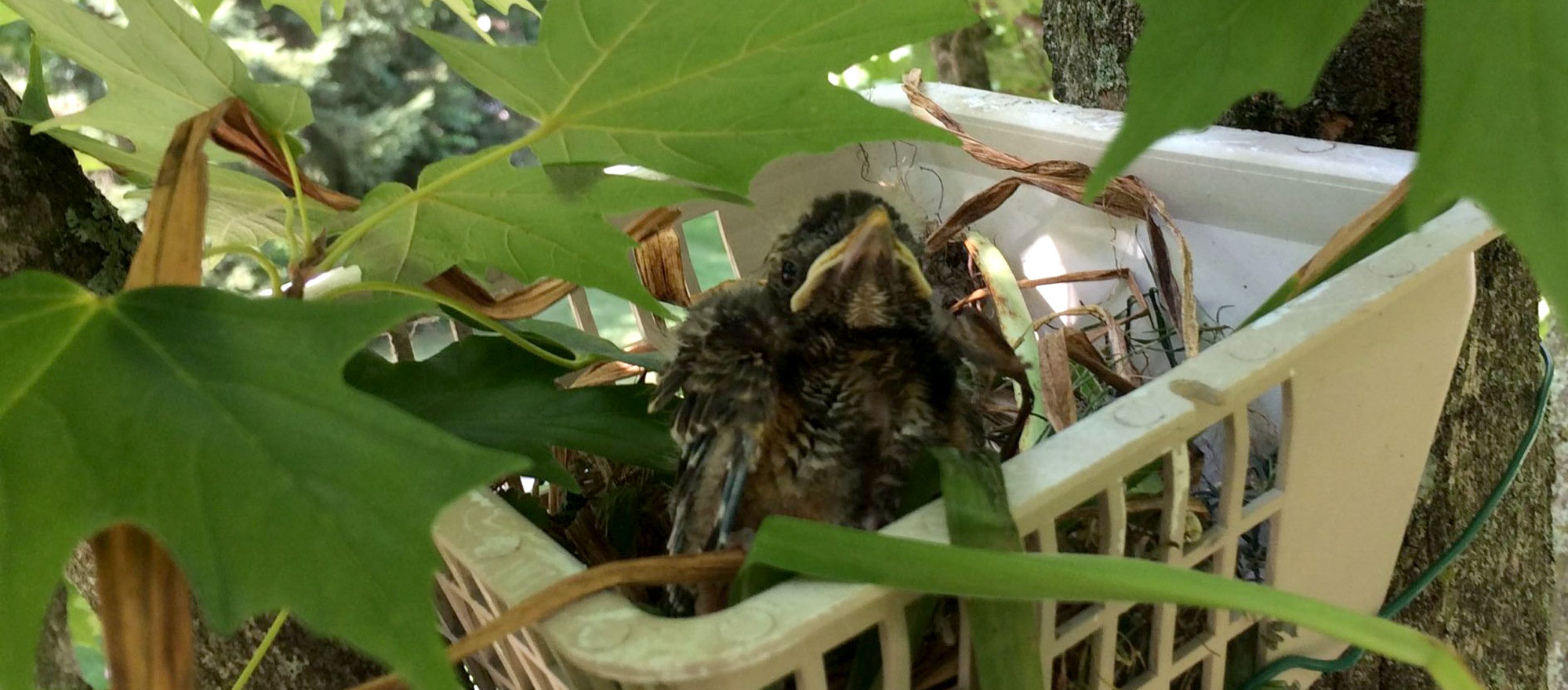
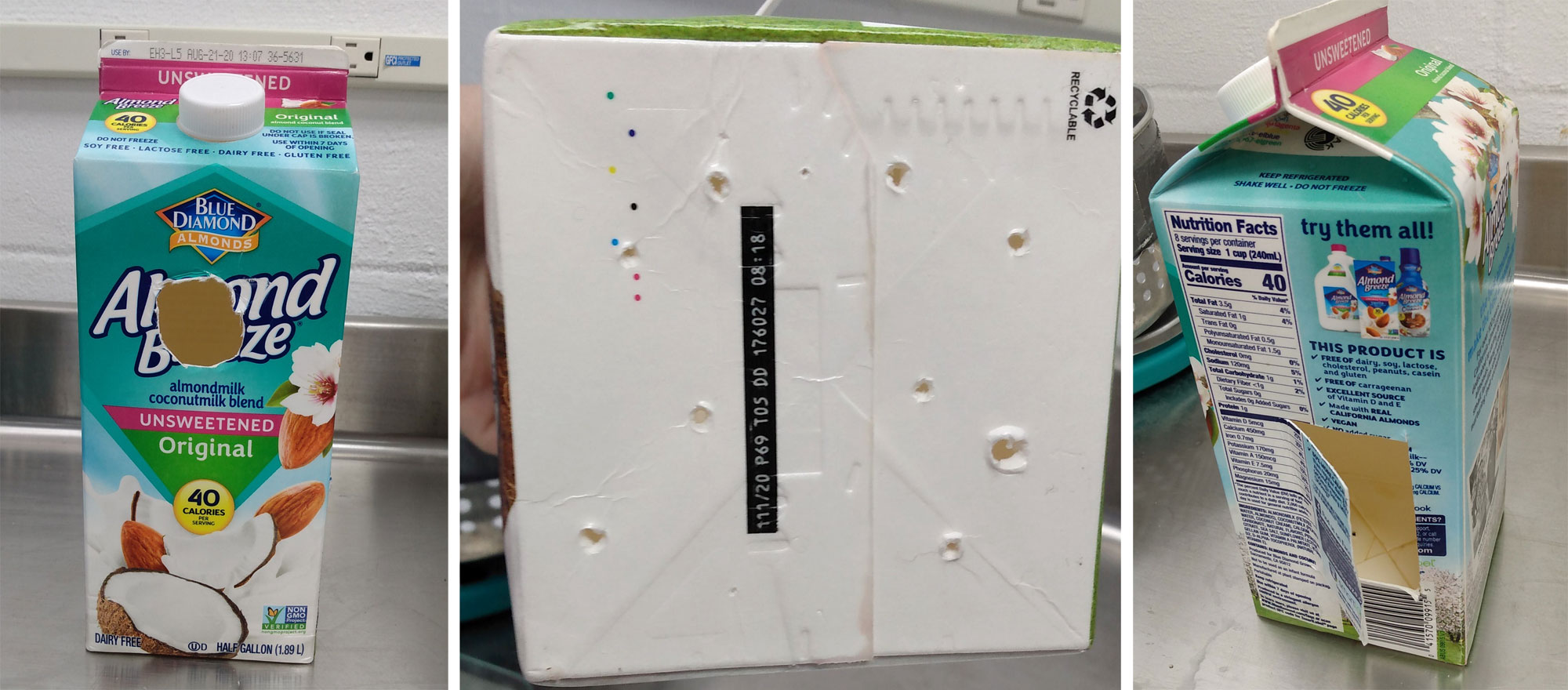
If there is no sign of injury – broken limb, head tilt, visible blood – accompany the child and retrace the path to the area where the bird was collected, then locate the nest site and replace the bird as described in “A baby bird fell out of a nest” above. Remember to confirm the presence of the bird parents.
If the original site cannot be located, the bird should be brought to the Wildlife Hospital for care.
You are probably seeing fledglings. The young fledgling birds are typically clumsy flyers when they are fresh out of the nest. They have not fully developed their flight muscles or skills and are somewhat uncoordinated.
Parent birds will continue to feed a fledgling on the ground for a couple weeks as it learns to fly, allowing it to gain more strength. Often, when people or animals try to approach grounded fledglings, the adults will mob (fly in a threatening manner) the intruder – this is normal and a good sign that the bird is being cared for. These grounded young birds are usually able to fly within a few days.
Although birds are vulnerable to predators, pets (especially outdoor cats) and children at this stage of development, this is a normal process, and it is crucial for the bird to learn to recognize these threats. Keep pets indoors or take them out on a leash when necessary to prevent pet attacks, and watch the fledgling to make sure the parents are still feeding the bird.
This is a very common occurrence. Please contain the bird using the directions linked below and transport the Wildlife Hospital immediately. We have learned new information when it comes to brain trauma in birds that does not show initially due to adrenaline, so getting them to us for a minimum 24 hours neurologic watch is very important.
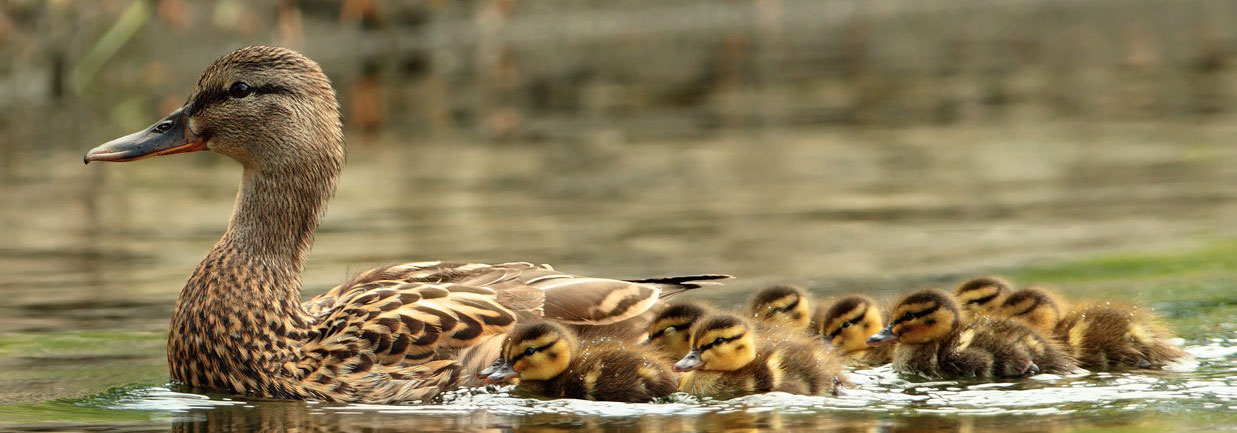
Most waterfowl lay their eggs away from water. They are capable of laying large numbers of eggs (12-14), which they incubate for about 28 days. After hatching, the mother leads the chicks to water on foot, which may be up to a mile away. Because they often have such a long hike to reach water, it is possible for healthy individuals to get separated from the rest of the group.

If reuniting is not possible, you can bring the animal(s) to our hospital. Please remember, humans are not a wild animal’s best chance for survival. It is always better to take extra time to search for parents before bringing them to us.
Call the non-emergency number for the local fire department for assistance. Drain covers may not be removed by members of the public.
If no one from the municipality is available to remove the cover, find a long-handled net such as a pool skimmer. Makeshift nets can also be made from hangers — you can unravel a wire hanger and thread it through the edge of a pillowcase, then continue to attach to a broom or another long pole with Duct Tape.

If reuniting is not possible, you can bring the animal(s) to our hospital. Please remember, humans are not a wild animal’s best chance for survival. It is always better to take extra time to search for parents before bringing them to us.
Birds and their nests (except starlings, house sparrows, and pigeons) are protected under federal law. You may not move nests or destroy eggs without first receiving permission from the Ohio Division of Natural Resources 1-800-WILDLIFE.
Most local waterfowl sit on the eggs for about one month.
Ohio Wildlife Center does not accept domestic ducks or geese. If you determine you do have a domestic species, you must call your local domestic pet shelter. Any duck, goose or swan that is banded (with a metal leg band or plastic neck band) is a wild species.
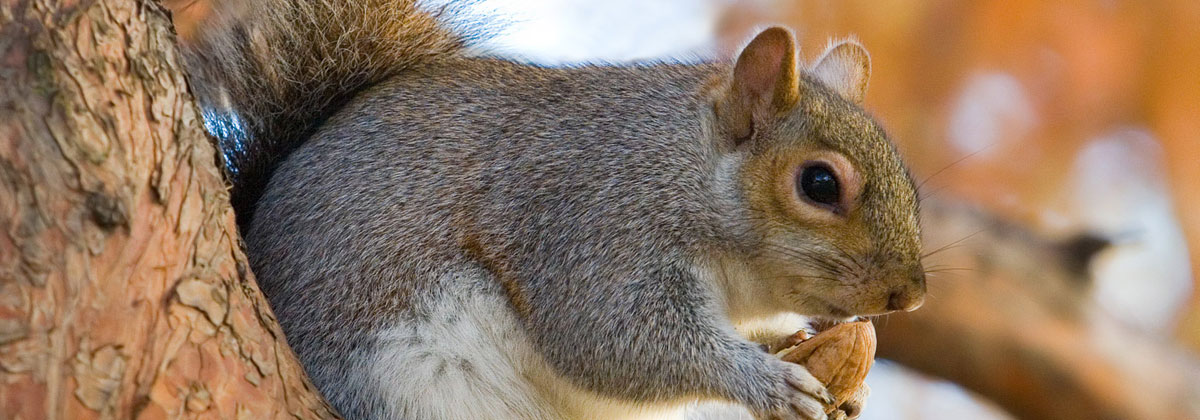
Litters of three to five Eastern gray squirrels are born in two seasons throughout the year: February/March and July/September. Squirrels are born hairless and with eyes and ears sealed shut. Their eyes open at 28 days, and babies are weaned around three to four months.
Mother squirrels are very loyal to their infants and will usually retrieve young that have fallen from their nest site. The mother will pick the infant up in her mouth and carry it back to the nest.
General Guidelines for Reuniting Infant Squirrels

The mother squirrel’s home range may be as large as eight acres. She will have multiple nest sites available, either in tree cavities or leaf nests. A typical leaf nest is a ball of leaves and twigs one to two feet in diameter, usually placed about 20 feet high in the tree.
If a nest becomes infested with fleas or mites, soiled with feces, or destroyed by a storm, the mother will carry her infants (one at a time) to a fresh nest within her territory. This can take time, especially if the alternate nest is on the opposite end of the mother’s territory.
If a young squirrel (eyes open, fully furred and mobile) approaches, follows or solicits human (or pet) contact, bring it into our hospital as soon as possible. Young squirrels, having been orphaned for nearly 72 hours, will begin to seek non-traditional food sources, including the unsuspecting human. It is considered a critical behavior when they begin to approach or follow people. In these situations, a few large pieces of fruit or vegetables (apples, melons, carrots, and a few shelled and unsalted nuts), if convenient, can be added to the container until the squirrel can be transported to our hospital.
The most common reasons for adult squirrel admission to the hospital are being hit by a car, electrocution and dog attacks.
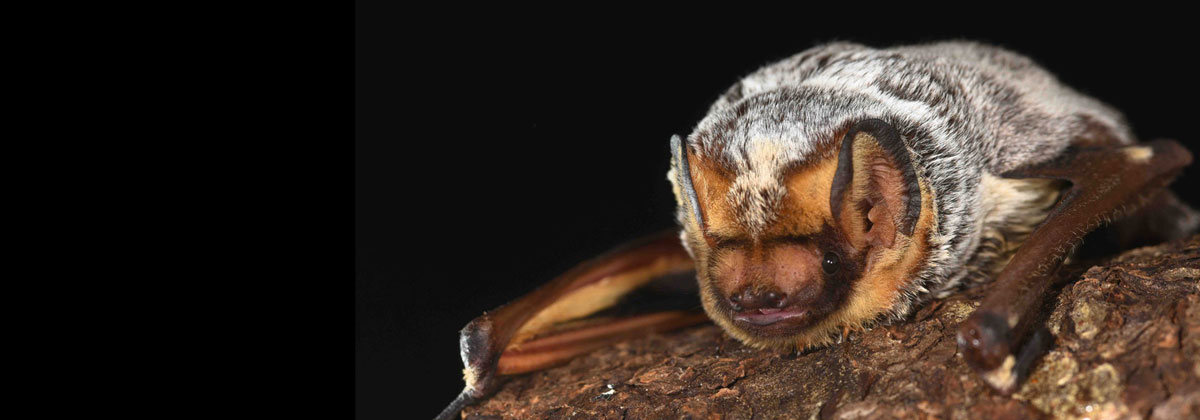
Bats should be approached with extreme caution. They are a high-risk mammal species for transmitting rabies to other mammals, including humans. It is highly advisable to seek professional assistance with bats. You can hire our certified wildlife professionals at SCRAM! Wildlife Control to assist in the collection of a bat in your home or yard.
Safely contain the animal and bring to the hospital.
Bats should be approached with extreme caution. They are a high-risk mammal species for transmitting rabies to other mammals, including humans. It is highly advisable to seek professional assistance with bats. You can hire our certified wildlife professionals at SCRAM! Wildlife Control to assist in the collection of a bat in your home or yard.
Bats should be approached with extreme caution. They are a high-risk mammal species for transmitting rabies to other mammals, including humans. It is highly advisable to seek professional assistance with bats. Call your local non-emergency police or sheriff to see if your city or township has animal control staff. You can hire our certified wildlife professionals at SCRAM! Wildlife Control to assist in the collection of a bat in your home or yard.
Bats in Ohio are very important ecologically and are a protected species. It is illegal to kill or willfully harm any bat. Please seek professional expertise due to human health concerns and exclusion success. Contact SCRAM! Wildlife Control, a unit of Ohio Wildlife Center, to discuss professional and permanent approaches to bat exclusions. Our certified technicians will inspect the attic, document openings, and work with you to create a plan to benefit the humans and the bats.
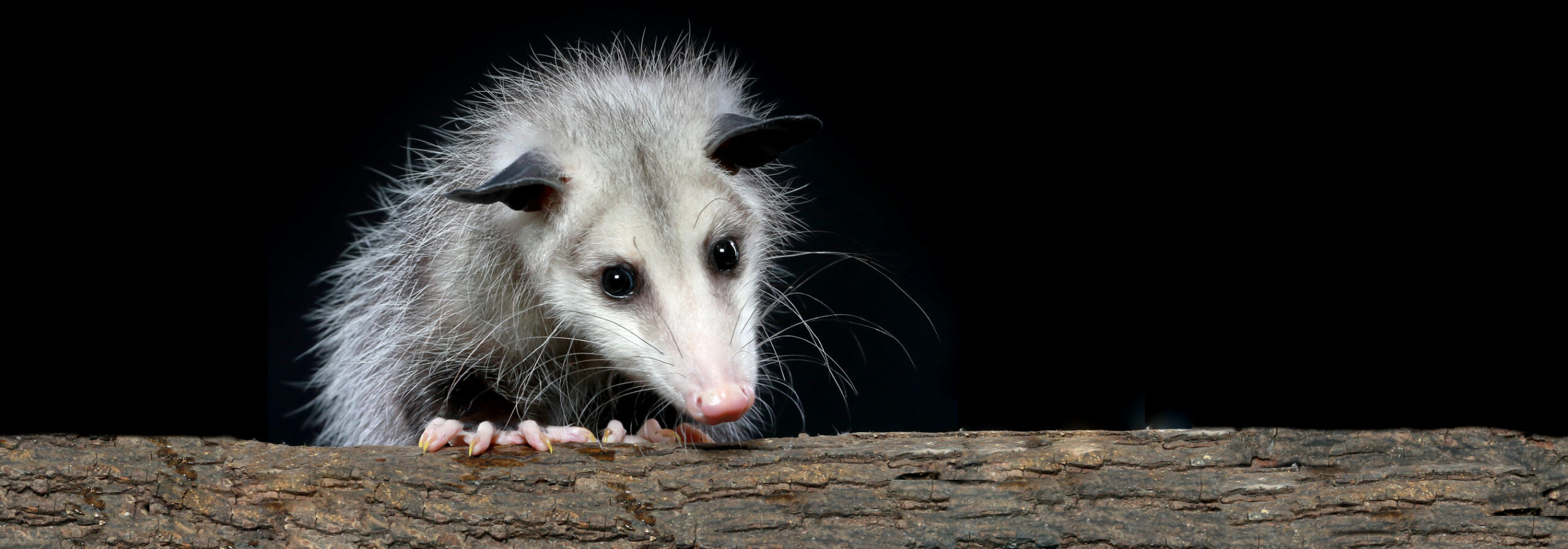
Leave it alone. Female opossums can have up to 13 offspring. As the babies develop and become too large for the pouch, they will begin to ride around on the mother’s back. It is very likely that one or more may fall off at any given time. As you can imagine, the mother would probably not miss one or two bodies riding around on her back. The mothers do not come back for lost babies.
If it is smaller than an average adult palm and is found alone, it should be brought to our hospital.
This species is a common victim of vehicle collisions. In spring and summer, most female opossums have young in their pouches. Sometimes the adult is killed or severely injured by the automobile, but the babies remain uninjured. If young are present and still alive, transport the entire (deceased) adult animal with babies to the Wildlife Hospital. We do not recommend you remove the babies from the pouch. Young bodies can be missed, and it also helps the hospital team to see the condition of the mother in order to provide the best medical care for the infants.
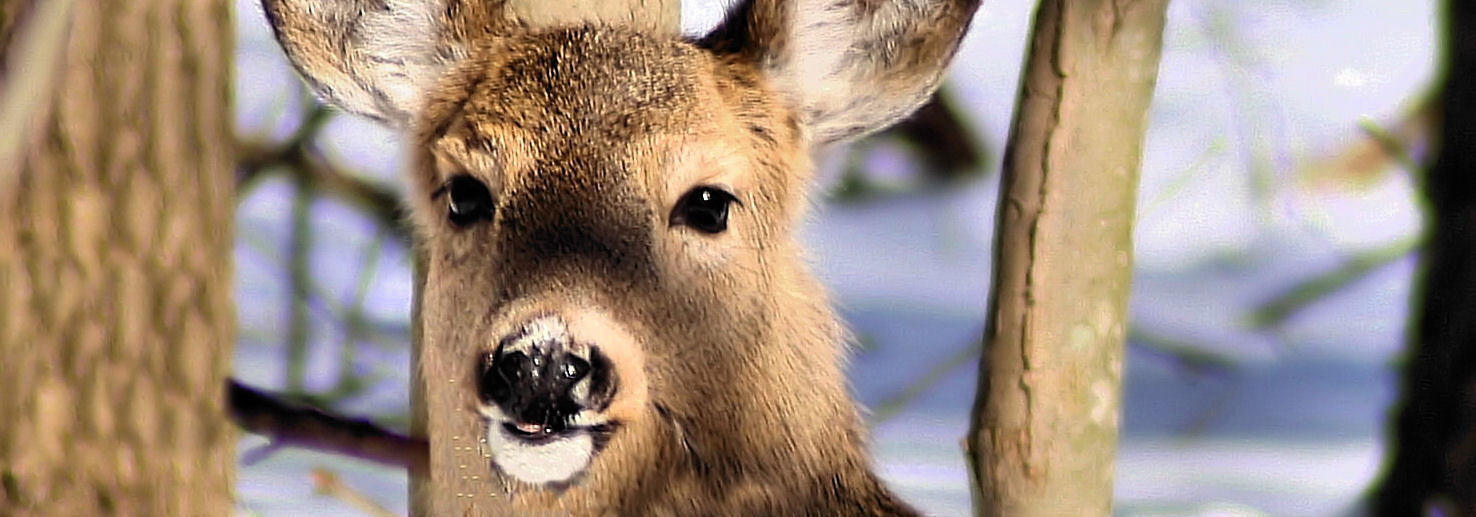
Please do not approach this animal, but instead monitor it at a safe distance. This is a dangerous animal and very difficult to help, even when injured. Please call your county’s wildlife officer to report the situation. If there is immediate public harm, please call your location’s non-emergency police or sheriff.
Deer can live in the wild with three legs. Even if it appears injured and hobbling, it has a good chance to heal, and leaving it alone is its best chance for survival. Keep an eye on it; if you see its condition worsening, call your county’s wildlife officer to report the situation.
Unless there is an adult deer (no spots) dead next to the fawn, it is likely not an orphan.
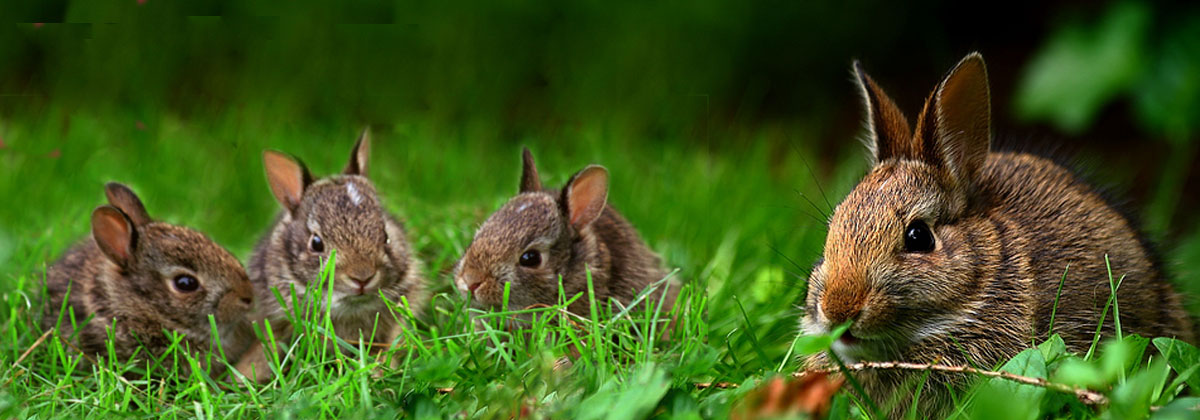
No. Moving the nest is extremely risky to the life of the bunnies. Since the mother feeds at dawn or dusk, or basically when the yard is not in use, the nest can be protected (rather than moved) while the yard is “in use” by people, pets or lawn mowers, as long as the mother has access to her young between sundown and sunup. Once you estimate the age of the babies, you can determine how long you will need to protect the nest (it will be no more than three weeks).
Guidelines for Protecting a Cottontail Nest

How long will I have to do this? The longest anyone needs to protect a nest is three weeks. If the babies in the nest already have their eyes open, they are at least a week old.
Domestic pets:
First, be sure it’s truly abandoned. A wild animal will rarely abandon her young.
Young rabbits leaving the nest will be about the size of a lemon, but are totally independent. They are bright, with open eyes, and able to hop and evade capture. These young rabbits may hang around the nest for a few days before dispersing, but the mother rabbit has already left to make a new nest and produce another litter.
If a group of babies is in a nest and not mobile, check for nest abandonment by putting string in a hash pattern across the nest or lining it with flour. Only the female raises the young, and visits and feeds mainly at night. By day, she hides under bushes or lies low in tall grass to avoid detection by predators. She is rarely seen near the nest during the day. If the string is disturbed or prints appear in the flour, the mother is tending to the young.
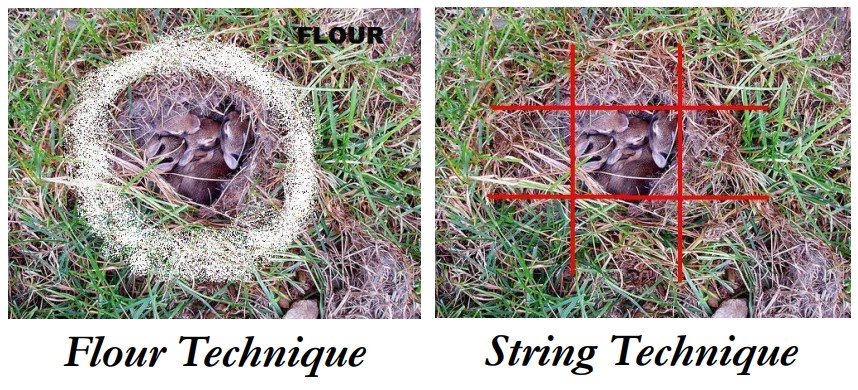
If the rabbits do not have ears up and are hopping around, and you follow them and determine the mother hasn’t returned, the rabbits are considered orphaned and must be admitted to hospital.
Human scent is not known to cause wild animals to abandon their young over short periods of time. If uninjured, the young should be reunited with their parents. Never feed young rabbits liquids of any kind.
Return the rabbits to the original nest location. The rabbit’s nest is usually a shallow depression in the ground, about four or five inches in diameter and lined with soft grasses and the mother’s fur. They are often difficult to spot, as they are usually covered in grass and fur when the mother leaves for the day. Nests may be found anywhere suitable cover and food sources are available together, including fields, back yards, forest edges, etc.
Once the young are returned to their nest, follow the techniques to confirm that the mother is returning at night. If a group of babies is in a nest and not mobile, check for nest abandonment by putting string in a hash pattern across the nest or lining it with flour. Only the female raises the young, and visits and feeds mainly at night. By day, she hides under bushes or lies low in tall grass to avoid detection by predators. She is rarely seen near the nest during the day. If the string is disturbed or prints appear in the flour, the mother is tending to the young. If the mother does not return, the rabbits are considered orphaned and must be admitted to the hospital.

Stop feeding the rabbits and take them to our Wildlife Hospital immediately. You must let the staff know what you’ve been feeding them for their best chance of survival. Rabbits have very sensitive gastrointestinal systems. Cow’s milk, evaporated milk, kitten milk replacement and puppy milk replacement are not suitable for wild rabbits. These foods will frequently lead to diarrhea, gastroenteritis and/or death.
If their eyes are open, you may put chemical-free (no pesticides, herbicides, etc.) dandelions, clover or grass from your yard in the box with the rabbits. Store-bought dark lettuce greens will also work.
Rabbits are prey animals and therefore very easily stressed in captivity. They should not be handled except to place them in a container for transportation. Over-handling is often fatal in this species.
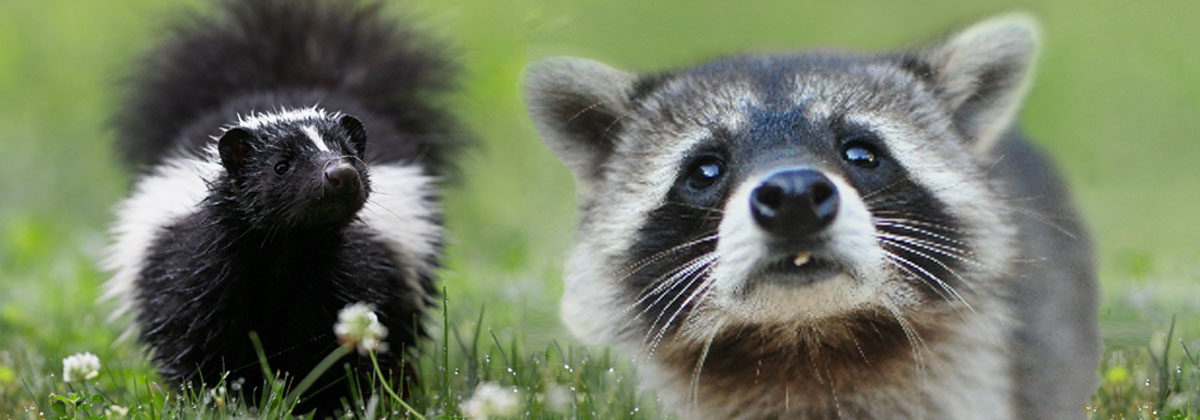
Please leave it alone. Raccoons or skunks should be approached with extreme caution. They are high-risk species for transmitting rabies to other mammals, including humans. It is highly advisable to seek professional assistance. Our professional technicians at SCRAM! Wildlife Control will come capture and transport the animal for a fee. Proceeds directly support our Wildlife Hospital. Skunks will also lift their tail and spray for protection when threatened. Please keep pets and children away from these situations.
Consider using a professional service that will not just trap and kill the animal. We recommend you seek professional services for difficult areas such as under decks or sheds. Contact our SCRAM! Wildlife Control certified technicians to inspect the problem area and work with you to find the best solution.
Raccoons or skunks should be approached with extreme caution. Although not likely in Central Ohio, they are high-risk species for transmitting rabies to other mammals, including humans. It is highly advisable to seek professional assistance. Skunks will also lift their tail and spray for protection when threatened. Please keep pets and children away from these situations.
Did you know raccoons and skunks usually have more than one nesting site? You can also try making the unwanted nest site less desirable to the mother in hopes that she may relocate her family on her own. It is best to use these techniques when the young are eyes open and mobile enough to follow their mother. If the mother must physically carry her young, this process may take some time and considerable energy on her part, but is the best option for allowing her to move at her own pace.
Humane techniques to make nest sites undesirable include:
Please don’t bring them in right away. It is unlikely that multiple young should be wandering around without an adult present. Adults rarely leave their offspring vulnerable to predators. It is likely that the young are orphans. However,
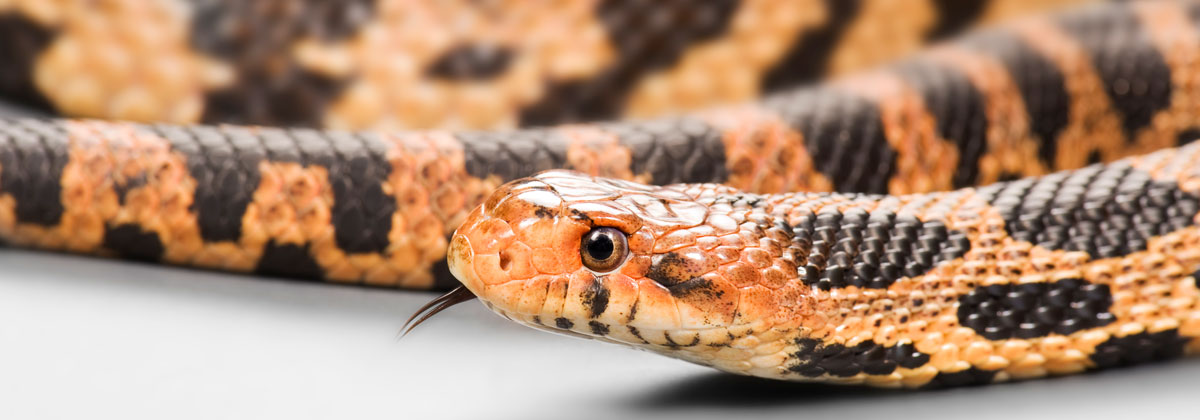
Yes. For a fee, we have certified technicians with our SCRAM! Wildlife Control team who will come and contain the snake.
Want to do it yourself? YES:
Use a broom or a long-handled object to coax the snake into a container and bring it to our hospital. Secure the lid and be sure there is ventilation. Snakes are cold-blooded reptiles and can’t be released outdoors in winter.
Use a broom or a long-handled object to coax the snake into a container and release it back outdoors. Snakes do not strike unless provoked and are great to have in your yard to control pests.
Please enjoy the sighting and leave it alone. There is a very slim chance of any snake found around Columbus to be venomous (correct term, not poisonous) unless a pet got loose. No snakes native to this area are venomous. General rule of thumb is that venomous snakes native to the United States have triangular-shaped heads and elliptical pupils. Snakes are beneficial for pest control of rodents and insects and do not strike unless provoked.
Place the turtle on the other side of the road in the direction it was headed. If someone already brought the turtle home, instruct them to take it back to the exact same location and put it in the direction it was headed.
CAUTION: If you have found a snapping turtle, only handle the turtle in the back third of its body by placing one hand at the base of the tail and the other hand on the plastron (bottom of the turtle). These are very powerful turtles that can inflict serious injury with their mouths.
Turtles must not be relocated. They must be released at the same site where they are found due to site fidelity and disease transmission possibilities.
Leave it alone! Bring all pets and children inside and allow the turtle to find its own path. We cannot protect every hatchling turtle from predation; they must make their own path. Turtles (even aquatic ones) don’t usually lay their eggs near water. When the turtles hatch, they must find their own way to water (if aquatic, they have a built-in GPS, so they will be able to find water if necessary) and they are perfectly capable of surviving on their own when very small.
Exception: If you find a turtle during the cold/winter months when turtles should be hibernating, you will need to pick it up carefully and put it in a secure box or container with ventilation and bring it to our hospital for evaluation. Do not feed it.
Ohio Wildlife Center never recommends that healthy wildlife be taken from the wild. See Laws Regarding Wildlife Possession.
If you have already made the choice to keep a healthy wild reptile or amphibian as a pet, there is a limit on how long it can be held in captivity before the animal is no longer considered to be a candidate for release.
If you have had the animal for under one month, it could come in for an evaluation to make sure it’s healthy and in good condition, but we recommend these animals be released where they were found. It must be returned to its original territory.
If you have had it for longer (months or years) and did not follow through with appropriate permitting, you have acted outside the law. There is no legal path for private ownership of wild caught native box turtles. There are some paths for private ownership of other reptiles and amphibians, but there are many additional steps to take. Call 1-800-WILDLIFE to discuss options.
No, our Wildlife Hospital cannot admit a non-native animal. Please reach out to the local humane societies, reptile rescues or exotic vets who may have a list of references to rehome the turtle.
NOTE: Red-eared sliders and yellow-bellied sliders found in the wild may not be rehabilitated in the state of Ohio per state regulations. These individuals must be euthanized upon arrival regardless of severity of injury.

Woodchucks should be approached with extreme caution. It is highly unlikely that a rodent like a woodchuck has rabies, but woodchucks sitting in vulnerable, visible locations for long periods of time, stumbling, circling or otherwise having difficulty moving may be ill or injured and should be brought to our hospital. If you are not comfortable safely containing the animal, our professional technicians at SCRAM! Wildlife Control will come capture and transport the animal for a fee. Proceeds directly support our Wildlife Hospital.
There is a chance the animal may have contracted Baylisascariasis, an internal parasite. It is not contagious, but the condition is not curable and the prognosis is poor. The disease progression leads to an inability to eat and a poor quality of life over a long period of time. Animals with this illness are also at a significant risk of walking into traffic. Capturing the animal to prevent further suffering may be a humane option.
It is unlikely that multiple young should be wandering around without an adult present. Adults rarely leave their offspring vulnerable to predators. It is likely that the young are orphans. Monitor the young for a four-hour period. If no adults are seen after that period, collect and bring them to our hospital.
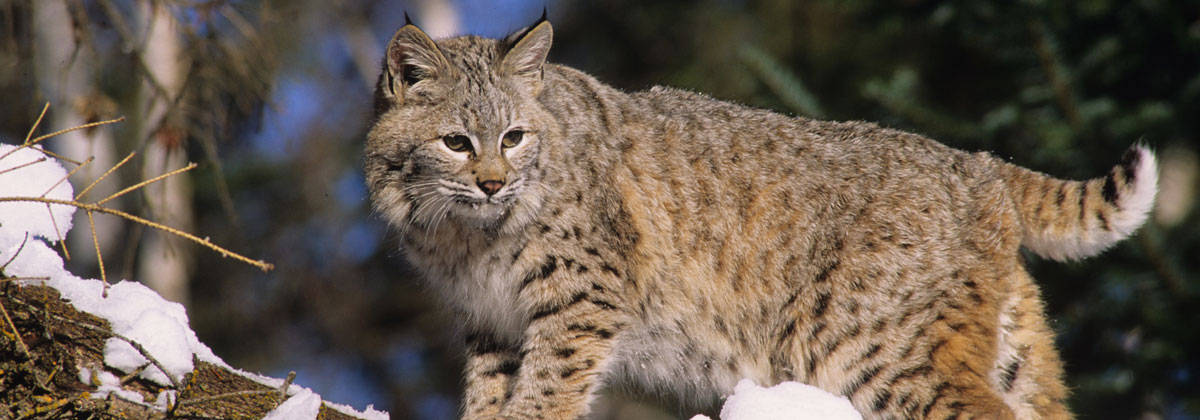
Please do not approach this animal, but instead monitor it at a safe distance. This is a dangerous animal and very difficult to help, even when injured. Please call your county’s wildlife officer to report the situation. If there is immediate public harm, please call your location’s non-emergency police or sheriff.
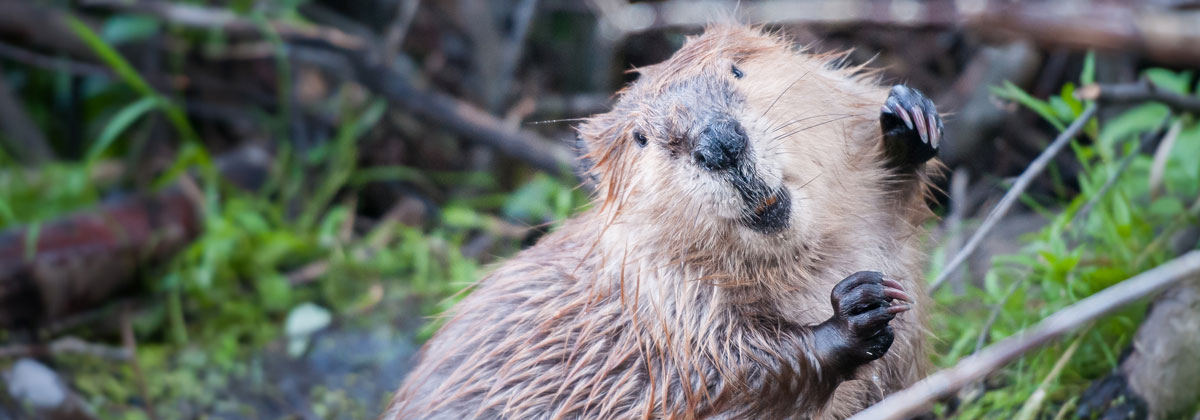
This animal needs immediate attention. However, do not put yourself in direct harm to help this animal. Do not attempt to get an animal off a highway or busy street without assistance. You can either safely contain the animal and bring to our Wildlife Hospital if it is safe to do so, or call the non-emergency police number for your location.
Trapping a healthy animal is almost never a good idea. Please consider releasing the animal back at the site where it was trapped. The better approach is to address the reason the animal is bothering you. The problem doesn’t end when you trap one animal. Another will come. We recommend you contact our certified, professional technicians at SCRAM! Wildlife Control, who will work with you to identify points of entry, ensure no babies are left behind and permanently exclude future animals. All proceeds from SCRAM! support our hospital.
Did you know Ohio state law regulations deem it illegal to relocate any animal with a high potential risk for rabies (skunk, raccoon, coyote, fox, bat), and also beavers and opossums? All healthy trapped animals of these species must be released where they were captured within 24 hours, or they must be euthanized, according to the law.
Did you also know it is illegal to “relocate” any animal, regardless of species, by dumping it in a Metro Park, State Park or any other public land without permission? Relocation is also very BAD for the animal:
Unfortunately, these babies are now considered “nuisance” progeny by state law in Ohio and must be euthanized. Specifically, young animals that have been orphaned or abandoned due to a purposeful action by a Commercial Nuisance Wild Animal Control Operator or a property owner cannot be rehabilitated. Call 1-800-WILDLIFE with any questions.
If you encounter a sick, injured or orphaned animal when our hospital is closed, provide temporary shelter in a quiet place away from children and pets. For older animals, keep contained in a dog crate, cat carrier or ventilated box. For infant animals, keep the patient warm and dry using a lidded box (such as a shoe box) with a cloth or towel on the bottom. A heating pad placed externally underneath the box (set on low) or a rice or birdseed bag (a sock filled with dry rice/seed, tie knot at end of sock and microwave for ~1 min) may be used to help keep the animal warm. If it’s a juvenile or older adult that is able to sit up and move around, you can provide a small amount of water (peanut butter jar lid).
Unless specifically advised to do so by Ohio Wildlife Center staff or a licensed wildlife rehabilitator, please DO NOT FEED THE ANIMAL. Many wild animals have very sensitive stomachs and require very special diets. Feeding an animal improper foods can lead to diarrhea, gastroenteritis and/or death.
If you have an issue with a wild animal on your premises, under your porch/deck, or in your attic or home that cannot be resolved, please contact 1-800- WILDLIFE to reach certified technicians.
For further information on found animals, including relevant agencies and state rules and regulations, check out our resource library.
For more information on dealing with found animals, contact Ohio Wildlife Center today.